Palliative Care Strategies: Managing COPD Symptoms in Mrs. Brown
VerifiedAdded on 2023/04/26
|7
|1901
|383
Report
AI Summary
This assignment provides a detailed analysis of palliative care applied to a 62-year-old female, Mrs. Brown, suffering from severe COPD symptoms. It highlights two primary nursing care priorities: managing respiratory problems, specifically chronic cough and breathlessness, and addressing the patient's depression and anxiety. The suggested strategies include a combined corticosteroid and bronchodilator therapy to alleviate respiratory symptoms and social support interventions to improve the patient's mental health. The paper supports these interventions with evidence from various studies, emphasizing the effectiveness of combined therapies for COPD and the importance of social support in managing psychological conditions associated with the disease. The overall goal is to improve Mrs. Brown's physical and psychological well-being through a holistic palliative care approach.

Running head: PALLIATIVE CARE
Palliative Care
Name of the Student
Name of the University
Author Note
Palliative Care
Name of the Student
Name of the University
Author Note
Paraphrase This Document
Need a fresh take? Get an instant paraphrase of this document with our AI Paraphraser
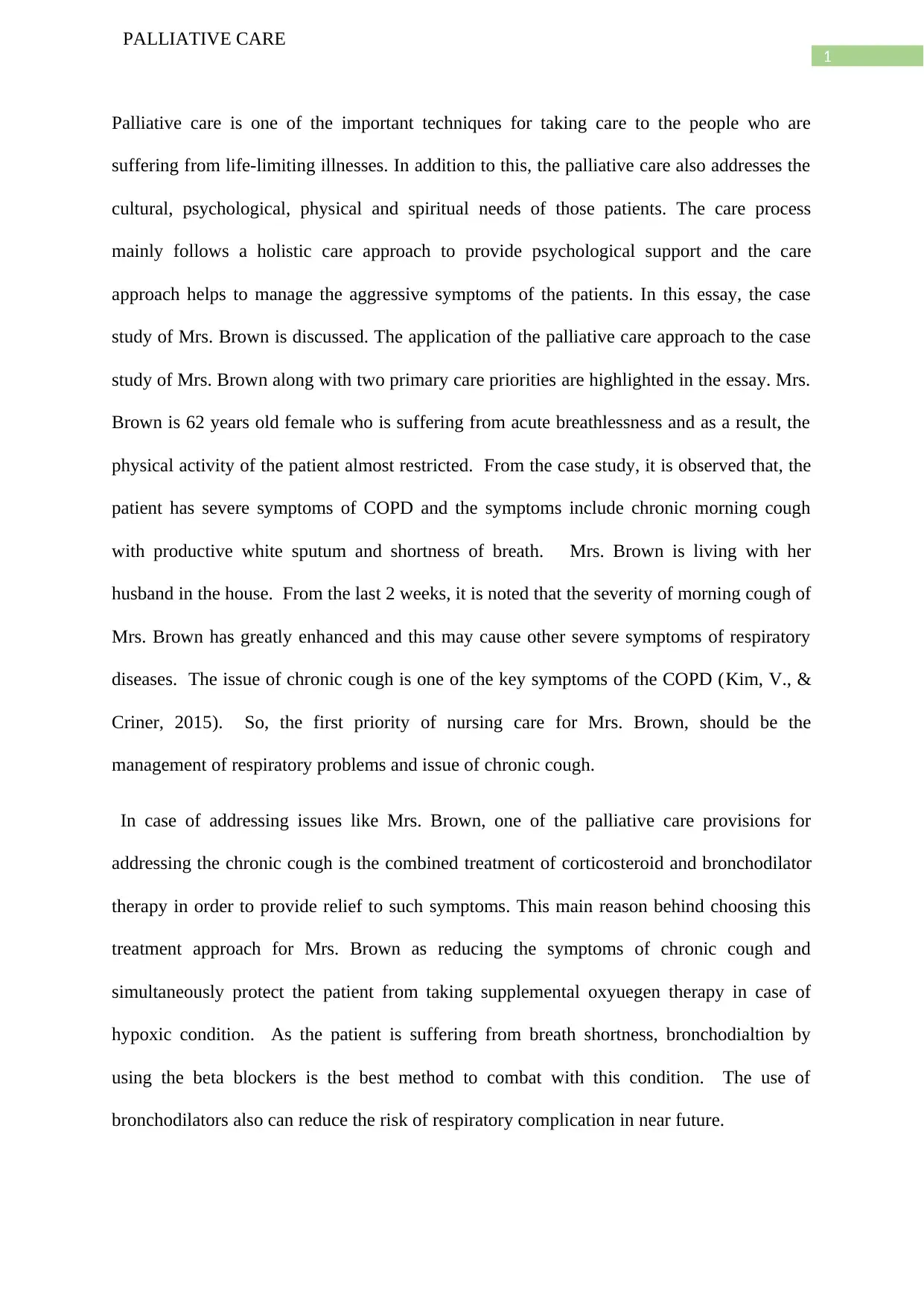
1
PALLIATIVE CARE
Palliative care is one of the important techniques for taking care to the people who are
suffering from life-limiting illnesses. In addition to this, the palliative care also addresses the
cultural, psychological, physical and spiritual needs of those patients. The care process
mainly follows a holistic care approach to provide psychological support and the care
approach helps to manage the aggressive symptoms of the patients. In this essay, the case
study of Mrs. Brown is discussed. The application of the palliative care approach to the case
study of Mrs. Brown along with two primary care priorities are highlighted in the essay. Mrs.
Brown is 62 years old female who is suffering from acute breathlessness and as a result, the
physical activity of the patient almost restricted. From the case study, it is observed that, the
patient has severe symptoms of COPD and the symptoms include chronic morning cough
with productive white sputum and shortness of breath. Mrs. Brown is living with her
husband in the house. From the last 2 weeks, it is noted that the severity of morning cough of
Mrs. Brown has greatly enhanced and this may cause other severe symptoms of respiratory
diseases. The issue of chronic cough is one of the key symptoms of the COPD (Kim, V., &
Criner, 2015). So, the first priority of nursing care for Mrs. Brown, should be the
management of respiratory problems and issue of chronic cough.
In case of addressing issues like Mrs. Brown, one of the palliative care provisions for
addressing the chronic cough is the combined treatment of corticosteroid and bronchodilator
therapy in order to provide relief to such symptoms. This main reason behind choosing this
treatment approach for Mrs. Brown as reducing the symptoms of chronic cough and
simultaneously protect the patient from taking supplemental oxyuegen therapy in case of
hypoxic condition. As the patient is suffering from breath shortness, bronchodialtion by
using the beta blockers is the best method to combat with this condition. The use of
bronchodilators also can reduce the risk of respiratory complication in near future.
PALLIATIVE CARE
Palliative care is one of the important techniques for taking care to the people who are
suffering from life-limiting illnesses. In addition to this, the palliative care also addresses the
cultural, psychological, physical and spiritual needs of those patients. The care process
mainly follows a holistic care approach to provide psychological support and the care
approach helps to manage the aggressive symptoms of the patients. In this essay, the case
study of Mrs. Brown is discussed. The application of the palliative care approach to the case
study of Mrs. Brown along with two primary care priorities are highlighted in the essay. Mrs.
Brown is 62 years old female who is suffering from acute breathlessness and as a result, the
physical activity of the patient almost restricted. From the case study, it is observed that, the
patient has severe symptoms of COPD and the symptoms include chronic morning cough
with productive white sputum and shortness of breath. Mrs. Brown is living with her
husband in the house. From the last 2 weeks, it is noted that the severity of morning cough of
Mrs. Brown has greatly enhanced and this may cause other severe symptoms of respiratory
diseases. The issue of chronic cough is one of the key symptoms of the COPD (Kim, V., &
Criner, 2015). So, the first priority of nursing care for Mrs. Brown, should be the
management of respiratory problems and issue of chronic cough.
In case of addressing issues like Mrs. Brown, one of the palliative care provisions for
addressing the chronic cough is the combined treatment of corticosteroid and bronchodilator
therapy in order to provide relief to such symptoms. This main reason behind choosing this
treatment approach for Mrs. Brown as reducing the symptoms of chronic cough and
simultaneously protect the patient from taking supplemental oxyuegen therapy in case of
hypoxic condition. As the patient is suffering from breath shortness, bronchodialtion by
using the beta blockers is the best method to combat with this condition. The use of
bronchodilators also can reduce the risk of respiratory complication in near future.
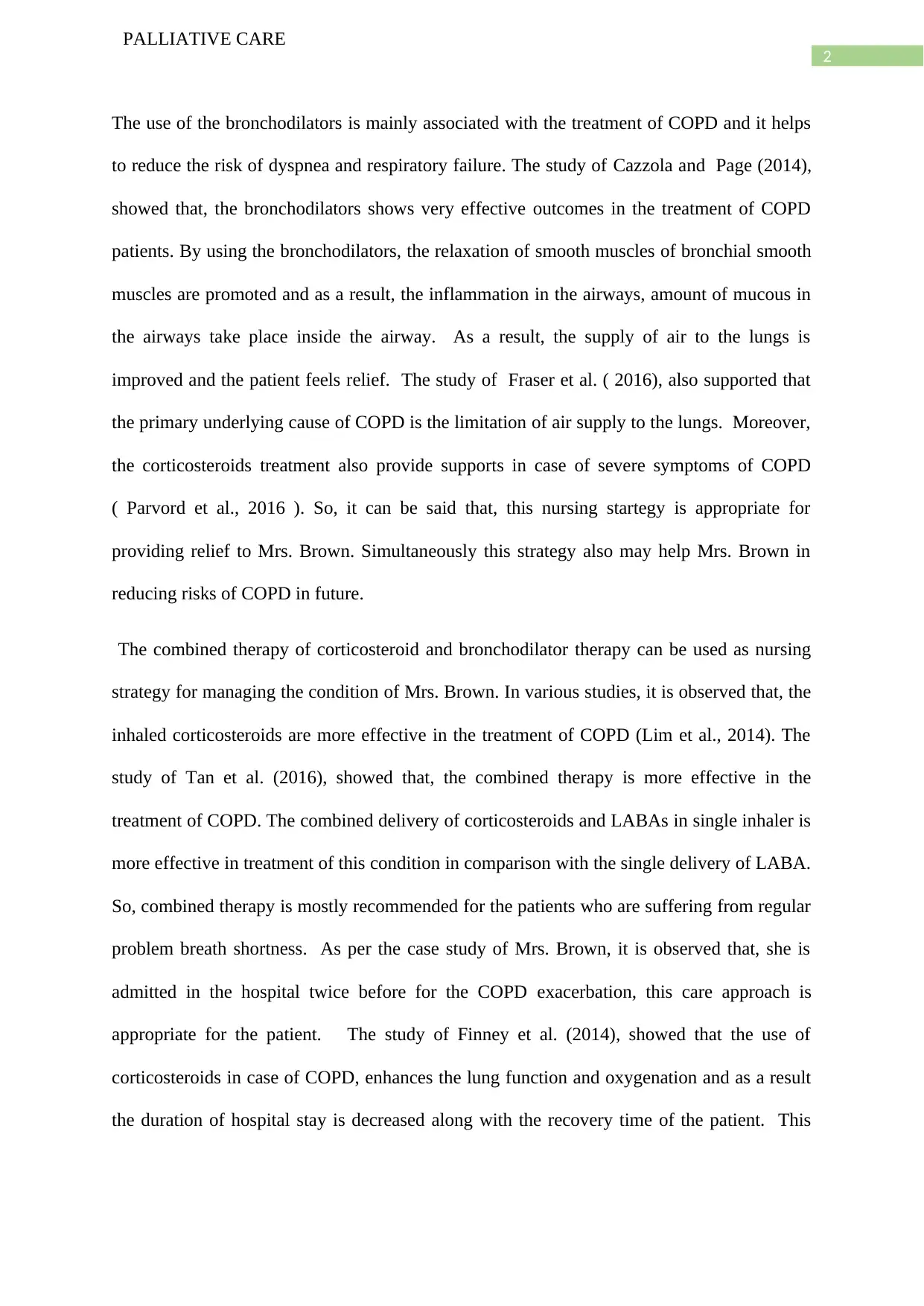
2
PALLIATIVE CARE
The use of the bronchodilators is mainly associated with the treatment of COPD and it helps
to reduce the risk of dyspnea and respiratory failure. The study of Cazzola and Page (2014),
showed that, the bronchodilators shows very effective outcomes in the treatment of COPD
patients. By using the bronchodilators, the relaxation of smooth muscles of bronchial smooth
muscles are promoted and as a result, the inflammation in the airways, amount of mucous in
the airways take place inside the airway. As a result, the supply of air to the lungs is
improved and the patient feels relief. The study of Fraser et al. ( 2016), also supported that
the primary underlying cause of COPD is the limitation of air supply to the lungs. Moreover,
the corticosteroids treatment also provide supports in case of severe symptoms of COPD
( Parvord et al., 2016 ). So, it can be said that, this nursing startegy is appropriate for
providing relief to Mrs. Brown. Simultaneously this strategy also may help Mrs. Brown in
reducing risks of COPD in future.
The combined therapy of corticosteroid and bronchodilator therapy can be used as nursing
strategy for managing the condition of Mrs. Brown. In various studies, it is observed that, the
inhaled corticosteroids are more effective in the treatment of COPD (Lim et al., 2014). The
study of Tan et al. (2016), showed that, the combined therapy is more effective in the
treatment of COPD. The combined delivery of corticosteroids and LABAs in single inhaler is
more effective in treatment of this condition in comparison with the single delivery of LABA.
So, combined therapy is mostly recommended for the patients who are suffering from regular
problem breath shortness. As per the case study of Mrs. Brown, it is observed that, she is
admitted in the hospital twice before for the COPD exacerbation, this care approach is
appropriate for the patient. The study of Finney et al. (2014), showed that the use of
corticosteroids in case of COPD, enhances the lung function and oxygenation and as a result
the duration of hospital stay is decreased along with the recovery time of the patient. This
PALLIATIVE CARE
The use of the bronchodilators is mainly associated with the treatment of COPD and it helps
to reduce the risk of dyspnea and respiratory failure. The study of Cazzola and Page (2014),
showed that, the bronchodilators shows very effective outcomes in the treatment of COPD
patients. By using the bronchodilators, the relaxation of smooth muscles of bronchial smooth
muscles are promoted and as a result, the inflammation in the airways, amount of mucous in
the airways take place inside the airway. As a result, the supply of air to the lungs is
improved and the patient feels relief. The study of Fraser et al. ( 2016), also supported that
the primary underlying cause of COPD is the limitation of air supply to the lungs. Moreover,
the corticosteroids treatment also provide supports in case of severe symptoms of COPD
( Parvord et al., 2016 ). So, it can be said that, this nursing startegy is appropriate for
providing relief to Mrs. Brown. Simultaneously this strategy also may help Mrs. Brown in
reducing risks of COPD in future.
The combined therapy of corticosteroid and bronchodilator therapy can be used as nursing
strategy for managing the condition of Mrs. Brown. In various studies, it is observed that, the
inhaled corticosteroids are more effective in the treatment of COPD (Lim et al., 2014). The
study of Tan et al. (2016), showed that, the combined therapy is more effective in the
treatment of COPD. The combined delivery of corticosteroids and LABAs in single inhaler is
more effective in treatment of this condition in comparison with the single delivery of LABA.
So, combined therapy is mostly recommended for the patients who are suffering from regular
problem breath shortness. As per the case study of Mrs. Brown, it is observed that, she is
admitted in the hospital twice before for the COPD exacerbation, this care approach is
appropriate for the patient. The study of Finney et al. (2014), showed that the use of
corticosteroids in case of COPD, enhances the lung function and oxygenation and as a result
the duration of hospital stay is decreased along with the recovery time of the patient. This
⊘ This is a preview!⊘
Do you want full access?
Subscribe today to unlock all pages.

Trusted by 1+ million students worldwide
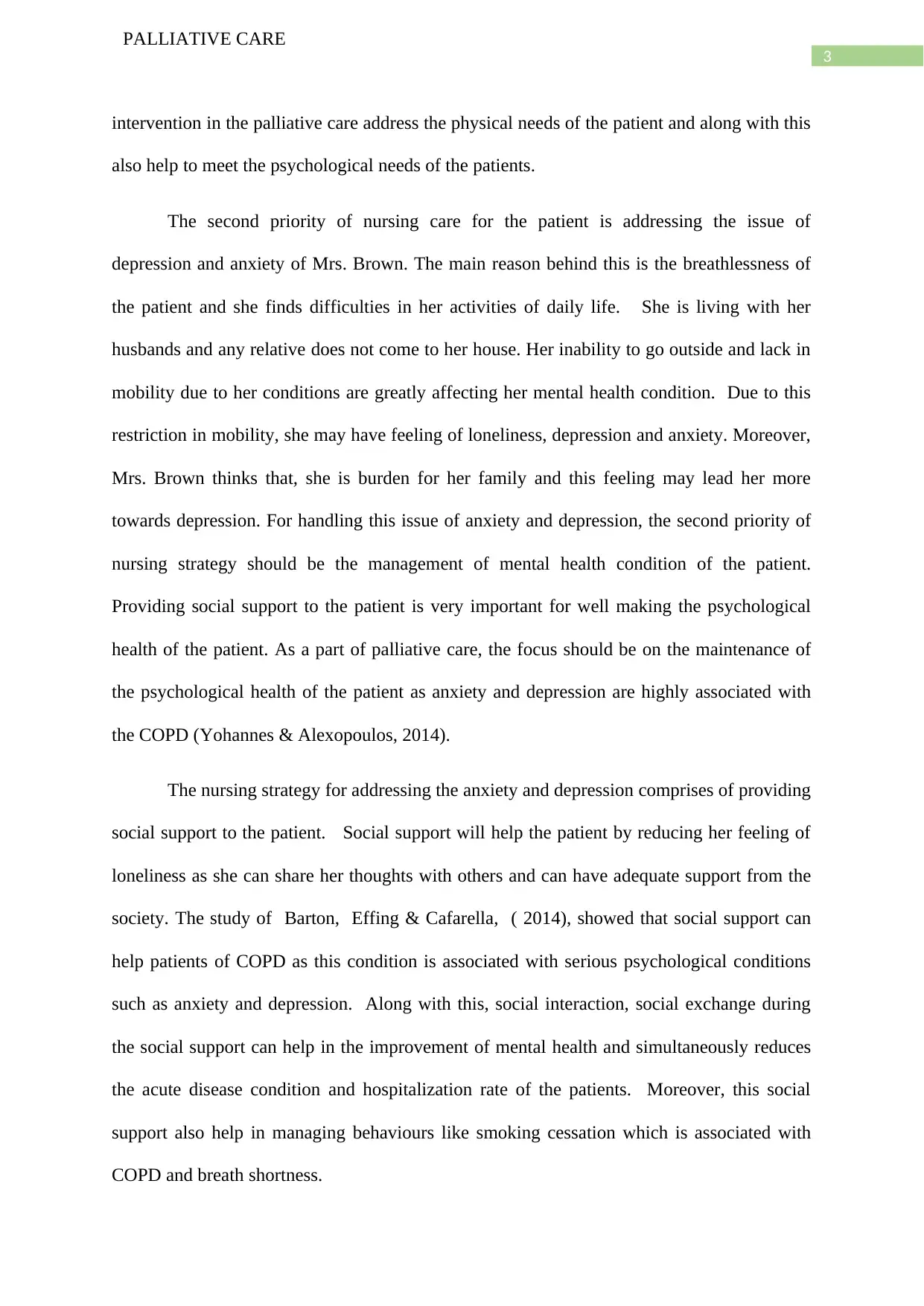
3
PALLIATIVE CARE
intervention in the palliative care address the physical needs of the patient and along with this
also help to meet the psychological needs of the patients.
The second priority of nursing care for the patient is addressing the issue of
depression and anxiety of Mrs. Brown. The main reason behind this is the breathlessness of
the patient and she finds difficulties in her activities of daily life. She is living with her
husbands and any relative does not come to her house. Her inability to go outside and lack in
mobility due to her conditions are greatly affecting her mental health condition. Due to this
restriction in mobility, she may have feeling of loneliness, depression and anxiety. Moreover,
Mrs. Brown thinks that, she is burden for her family and this feeling may lead her more
towards depression. For handling this issue of anxiety and depression, the second priority of
nursing strategy should be the management of mental health condition of the patient.
Providing social support to the patient is very important for well making the psychological
health of the patient. As a part of palliative care, the focus should be on the maintenance of
the psychological health of the patient as anxiety and depression are highly associated with
the COPD (Yohannes & Alexopoulos, 2014).
The nursing strategy for addressing the anxiety and depression comprises of providing
social support to the patient. Social support will help the patient by reducing her feeling of
loneliness as she can share her thoughts with others and can have adequate support from the
society. The study of Barton, Effing & Cafarella, ( 2014), showed that social support can
help patients of COPD as this condition is associated with serious psychological conditions
such as anxiety and depression. Along with this, social interaction, social exchange during
the social support can help in the improvement of mental health and simultaneously reduces
the acute disease condition and hospitalization rate of the patients. Moreover, this social
support also help in managing behaviours like smoking cessation which is associated with
COPD and breath shortness.
PALLIATIVE CARE
intervention in the palliative care address the physical needs of the patient and along with this
also help to meet the psychological needs of the patients.
The second priority of nursing care for the patient is addressing the issue of
depression and anxiety of Mrs. Brown. The main reason behind this is the breathlessness of
the patient and she finds difficulties in her activities of daily life. She is living with her
husbands and any relative does not come to her house. Her inability to go outside and lack in
mobility due to her conditions are greatly affecting her mental health condition. Due to this
restriction in mobility, she may have feeling of loneliness, depression and anxiety. Moreover,
Mrs. Brown thinks that, she is burden for her family and this feeling may lead her more
towards depression. For handling this issue of anxiety and depression, the second priority of
nursing strategy should be the management of mental health condition of the patient.
Providing social support to the patient is very important for well making the psychological
health of the patient. As a part of palliative care, the focus should be on the maintenance of
the psychological health of the patient as anxiety and depression are highly associated with
the COPD (Yohannes & Alexopoulos, 2014).
The nursing strategy for addressing the anxiety and depression comprises of providing
social support to the patient. Social support will help the patient by reducing her feeling of
loneliness as she can share her thoughts with others and can have adequate support from the
society. The study of Barton, Effing & Cafarella, ( 2014), showed that social support can
help patients of COPD as this condition is associated with serious psychological conditions
such as anxiety and depression. Along with this, social interaction, social exchange during
the social support can help in the improvement of mental health and simultaneously reduces
the acute disease condition and hospitalization rate of the patients. Moreover, this social
support also help in managing behaviours like smoking cessation which is associated with
COPD and breath shortness.
Paraphrase This Document
Need a fresh take? Get an instant paraphrase of this document with our AI Paraphraser
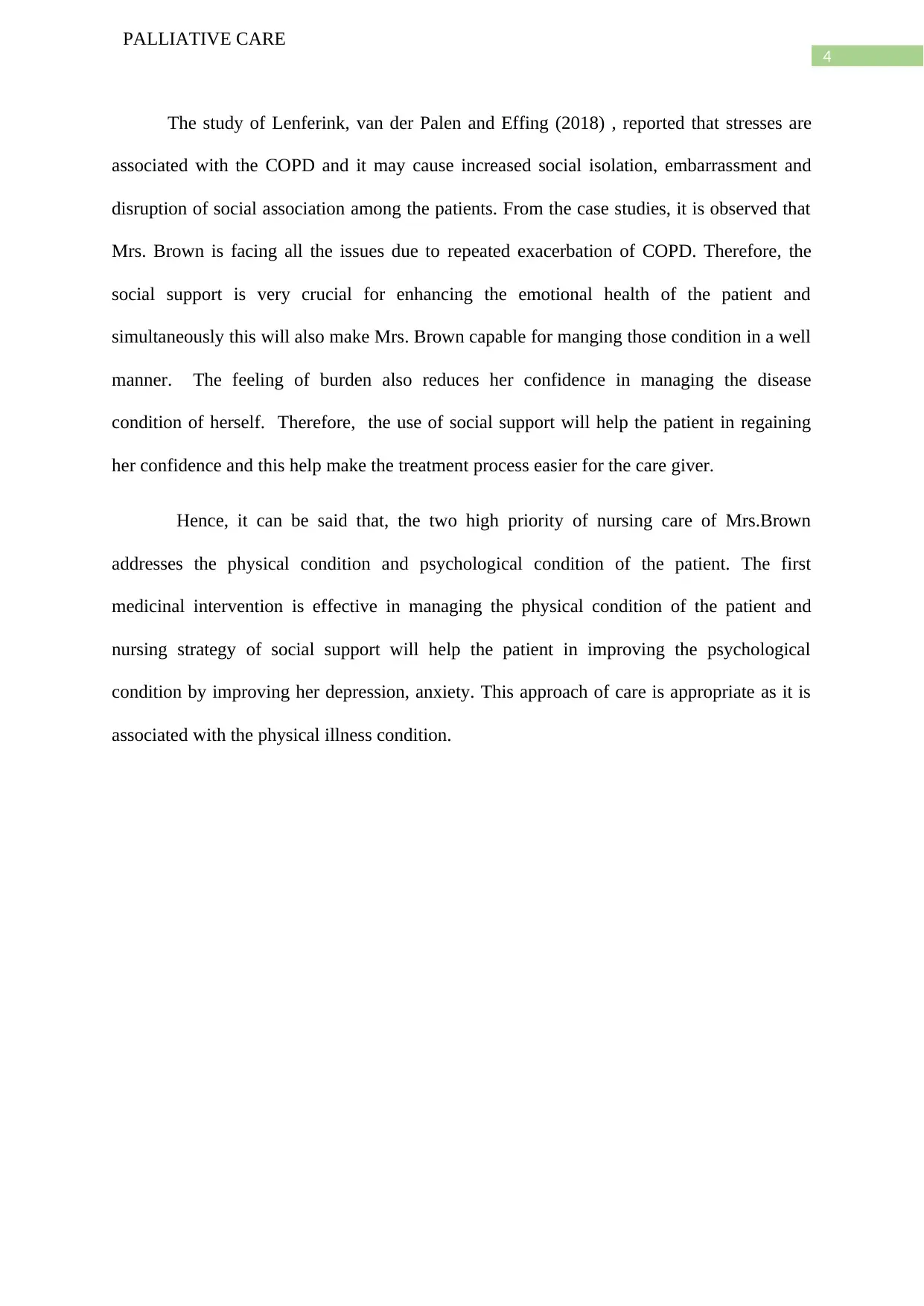
4
PALLIATIVE CARE
The study of Lenferink, van der Palen and Effing (2018) , reported that stresses are
associated with the COPD and it may cause increased social isolation, embarrassment and
disruption of social association among the patients. From the case studies, it is observed that
Mrs. Brown is facing all the issues due to repeated exacerbation of COPD. Therefore, the
social support is very crucial for enhancing the emotional health of the patient and
simultaneously this will also make Mrs. Brown capable for manging those condition in a well
manner. The feeling of burden also reduces her confidence in managing the disease
condition of herself. Therefore, the use of social support will help the patient in regaining
her confidence and this help make the treatment process easier for the care giver.
Hence, it can be said that, the two high priority of nursing care of Mrs.Brown
addresses the physical condition and psychological condition of the patient. The first
medicinal intervention is effective in managing the physical condition of the patient and
nursing strategy of social support will help the patient in improving the psychological
condition by improving her depression, anxiety. This approach of care is appropriate as it is
associated with the physical illness condition.
PALLIATIVE CARE
The study of Lenferink, van der Palen and Effing (2018) , reported that stresses are
associated with the COPD and it may cause increased social isolation, embarrassment and
disruption of social association among the patients. From the case studies, it is observed that
Mrs. Brown is facing all the issues due to repeated exacerbation of COPD. Therefore, the
social support is very crucial for enhancing the emotional health of the patient and
simultaneously this will also make Mrs. Brown capable for manging those condition in a well
manner. The feeling of burden also reduces her confidence in managing the disease
condition of herself. Therefore, the use of social support will help the patient in regaining
her confidence and this help make the treatment process easier for the care giver.
Hence, it can be said that, the two high priority of nursing care of Mrs.Brown
addresses the physical condition and psychological condition of the patient. The first
medicinal intervention is effective in managing the physical condition of the patient and
nursing strategy of social support will help the patient in improving the psychological
condition by improving her depression, anxiety. This approach of care is appropriate as it is
associated with the physical illness condition.
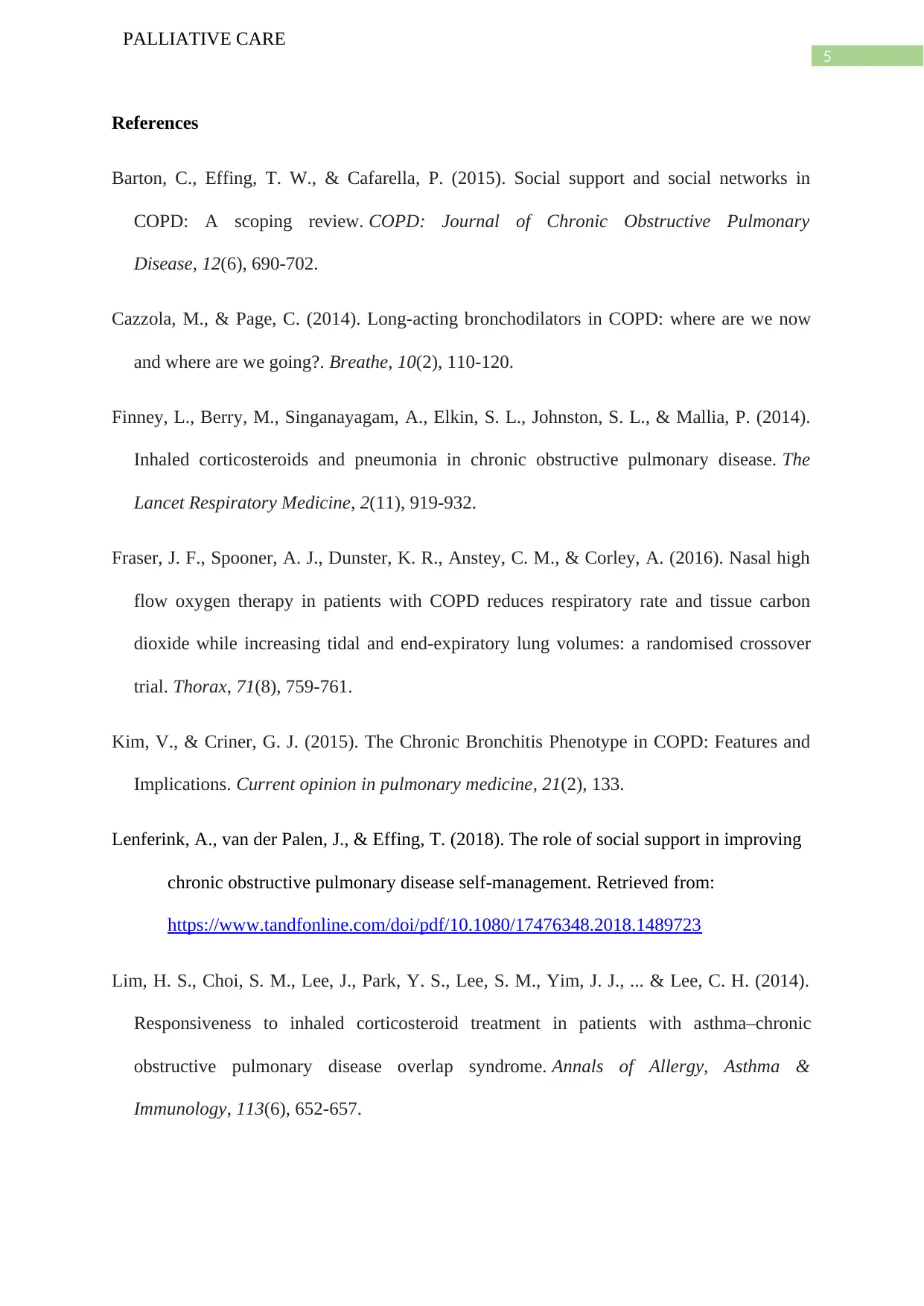
5
PALLIATIVE CARE
References
Barton, C., Effing, T. W., & Cafarella, P. (2015). Social support and social networks in
COPD: A scoping review. COPD: Journal of Chronic Obstructive Pulmonary
Disease, 12(6), 690-702.
Cazzola, M., & Page, C. (2014). Long-acting bronchodilators in COPD: where are we now
and where are we going?. Breathe, 10(2), 110-120.
Finney, L., Berry, M., Singanayagam, A., Elkin, S. L., Johnston, S. L., & Mallia, P. (2014).
Inhaled corticosteroids and pneumonia in chronic obstructive pulmonary disease. The
Lancet Respiratory Medicine, 2(11), 919-932.
Fraser, J. F., Spooner, A. J., Dunster, K. R., Anstey, C. M., & Corley, A. (2016). Nasal high
flow oxygen therapy in patients with COPD reduces respiratory rate and tissue carbon
dioxide while increasing tidal and end-expiratory lung volumes: a randomised crossover
trial. Thorax, 71(8), 759-761.
Kim, V., & Criner, G. J. (2015). The Chronic Bronchitis Phenotype in COPD: Features and
Implications. Current opinion in pulmonary medicine, 21(2), 133.
Lenferink, A., van der Palen, J., & Effing, T. (2018). The role of social support in improving
chronic obstructive pulmonary disease self-management. Retrieved from:
https://www.tandfonline.com/doi/pdf/10.1080/17476348.2018.1489723
Lim, H. S., Choi, S. M., Lee, J., Park, Y. S., Lee, S. M., Yim, J. J., ... & Lee, C. H. (2014).
Responsiveness to inhaled corticosteroid treatment in patients with asthma–chronic
obstructive pulmonary disease overlap syndrome. Annals of Allergy, Asthma &
Immunology, 113(6), 652-657.
PALLIATIVE CARE
References
Barton, C., Effing, T. W., & Cafarella, P. (2015). Social support and social networks in
COPD: A scoping review. COPD: Journal of Chronic Obstructive Pulmonary
Disease, 12(6), 690-702.
Cazzola, M., & Page, C. (2014). Long-acting bronchodilators in COPD: where are we now
and where are we going?. Breathe, 10(2), 110-120.
Finney, L., Berry, M., Singanayagam, A., Elkin, S. L., Johnston, S. L., & Mallia, P. (2014).
Inhaled corticosteroids and pneumonia in chronic obstructive pulmonary disease. The
Lancet Respiratory Medicine, 2(11), 919-932.
Fraser, J. F., Spooner, A. J., Dunster, K. R., Anstey, C. M., & Corley, A. (2016). Nasal high
flow oxygen therapy in patients with COPD reduces respiratory rate and tissue carbon
dioxide while increasing tidal and end-expiratory lung volumes: a randomised crossover
trial. Thorax, 71(8), 759-761.
Kim, V., & Criner, G. J. (2015). The Chronic Bronchitis Phenotype in COPD: Features and
Implications. Current opinion in pulmonary medicine, 21(2), 133.
Lenferink, A., van der Palen, J., & Effing, T. (2018). The role of social support in improving
chronic obstructive pulmonary disease self-management. Retrieved from:
https://www.tandfonline.com/doi/pdf/10.1080/17476348.2018.1489723
Lim, H. S., Choi, S. M., Lee, J., Park, Y. S., Lee, S. M., Yim, J. J., ... & Lee, C. H. (2014).
Responsiveness to inhaled corticosteroid treatment in patients with asthma–chronic
obstructive pulmonary disease overlap syndrome. Annals of Allergy, Asthma &
Immunology, 113(6), 652-657.
⊘ This is a preview!⊘
Do you want full access?
Subscribe today to unlock all pages.

Trusted by 1+ million students worldwide
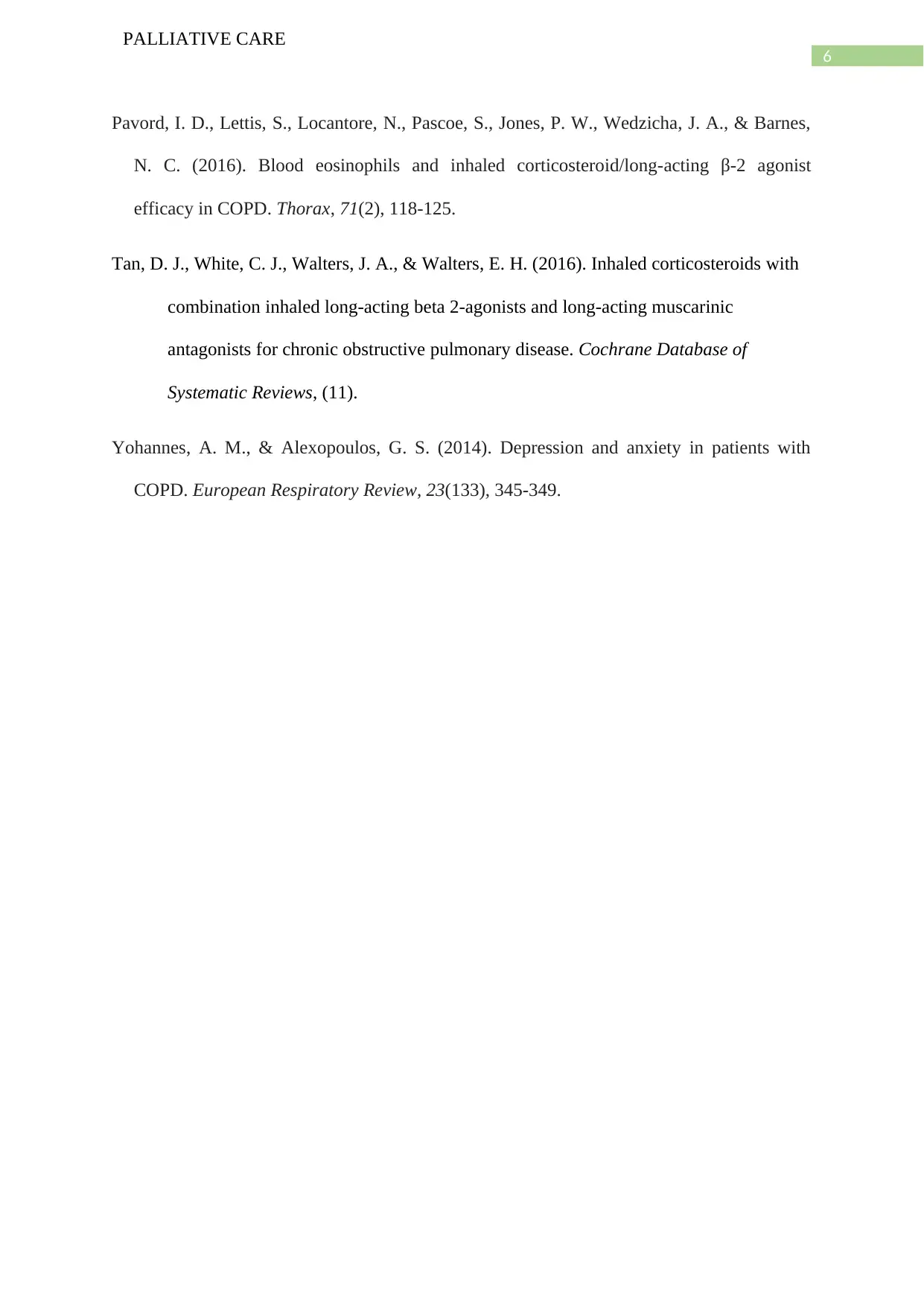
6
PALLIATIVE CARE
Pavord, I. D., Lettis, S., Locantore, N., Pascoe, S., Jones, P. W., Wedzicha, J. A., & Barnes,
N. C. (2016). Blood eosinophils and inhaled corticosteroid/long-acting β-2 agonist
efficacy in COPD. Thorax, 71(2), 118-125.
Tan, D. J., White, C. J., Walters, J. A., & Walters, E. H. (2016). Inhaled corticosteroids with
combination inhaled long‐acting beta 2‐agonists and long‐acting muscarinic
antagonists for chronic obstructive pulmonary disease. Cochrane Database of
Systematic Reviews, (11).
Yohannes, A. M., & Alexopoulos, G. S. (2014). Depression and anxiety in patients with
COPD. European Respiratory Review, 23(133), 345-349.
PALLIATIVE CARE
Pavord, I. D., Lettis, S., Locantore, N., Pascoe, S., Jones, P. W., Wedzicha, J. A., & Barnes,
N. C. (2016). Blood eosinophils and inhaled corticosteroid/long-acting β-2 agonist
efficacy in COPD. Thorax, 71(2), 118-125.
Tan, D. J., White, C. J., Walters, J. A., & Walters, E. H. (2016). Inhaled corticosteroids with
combination inhaled long‐acting beta 2‐agonists and long‐acting muscarinic
antagonists for chronic obstructive pulmonary disease. Cochrane Database of
Systematic Reviews, (11).
Yohannes, A. M., & Alexopoulos, G. S. (2014). Depression and anxiety in patients with
COPD. European Respiratory Review, 23(133), 345-349.
1 out of 7
Related Documents
Your All-in-One AI-Powered Toolkit for Academic Success.
+13062052269
info@desklib.com
Available 24*7 on WhatsApp / Email
![[object Object]](/_next/static/media/star-bottom.7253800d.svg)
Unlock your academic potential
Copyright © 2020–2025 A2Z Services. All Rights Reserved. Developed and managed by ZUCOL.





